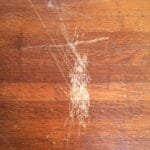Imagine you’re relaxing on your favorite leather couch, only to notice an unsightly large hole marring its elegant surface. Your heart sinks, and you wonder if your beloved couch is ruined forever.
You might feel a mix of frustration and anxiety, but don’t worry—there’s a solution! Whether it’s an accidental tear or an unfortunate spill, fixing a large hole in a leather couch is easier than you might think. This article will guide you through straightforward steps to restore your couch’s beauty, while saving you from the hefty cost of professional repairs or replacement.
You’ll discover practical tips and techniques that make the repair process simple and effective. So, let’s dive in and transform your leather couch back to its pristine condition. Stay with us, because you’ll want every insider tip we have to offer!

Credit: www.youtube.com
Assessing The Damage
Inspecting the damage on a leather couch involves checking the hole’s size and shape. Carefully trim loose edges to prepare for repair. Secure a patch using leather adhesive, ensuring it matches in color and texture.
When you discover a large hole in your leather couch, it can be quite disheartening. But before you rush to find a solution, take a moment to assess the damage. Understanding the extent and nature of the hole will guide you in choosing the right repair method. This step is crucial if you want your couch to look as good as new.Size And Location Of The Hole
The first thing you should do is evaluate the size of the hole. Is it small enough for a simple patch, or does it require a more comprehensive repair? A hole that is a few inches wide may be manageable with a leather repair kit. Larger holes might require professional attention or more intricate solutions. Equally important is the location of the damage. Is it in a high-stress area, like the seat cushion, where it may expand over time? Or is it on the side or back where it’s less likely to worsen? The location will help you determine if the repair needs to be extra durable or if aesthetics are more important.Type Of Leather
Next, identify the type of leather your couch is made from. Different leathers, such as full-grain, top-grain, or bonded, require different repair materials and techniques. Knowing the type of leather will help you select the correct products and avoid further damage. If you’re unsure about the leather type, check any tags or documentation that came with your couch. Alternatively, you can consult a professional to avoid making an irreversible mistake. Understanding the material is key to executing a repair that blends seamlessly with the rest of the couch. Taking the time to assess the damage thoroughly can save you from future headaches. Remember, a well-informed repair is often a successful one. What do you think? Is it better to tackle a repair yourself or call in the experts?
Credit: www.ifixit.com
Gathering Necessary Materials
Fixing a large hole in a leather couch starts with the right materials. Choosing the correct supplies ensures a smooth and durable repair. Each item plays a crucial role in restoring the couch’s look and feel. Let’s explore what you need for this project.
Leather Repair Kit
A leather repair kit is essential. It includes patches, tools, and instructions. These kits simplify the repair process. They help you achieve a professional finish. Ensure the kit matches your leather type for best results.
Adhesives And Fillers
Adhesives and fillers are vital for patching holes. Strong adhesives keep the patches in place. Fillers smooth out rough edges and gaps. Choose products that bond well with leather. They ensure a seamless repair.
Color Matching Tools
Color matching tools help restore the couch’s original look. Use them to find the right shade. Some kits include color mixing guides. These tools help blend the patch with the surrounding leather. A precise match hides the repair effectively.
Preparing The Couch Surface
Repairing a large hole in a leather couch can seem daunting. But with the right preparation, the task becomes manageable. Preparing the couch surface is crucial before you start repairing. This step ensures the patch adheres properly and the repair looks seamless. Let’s dive into the steps involved in preparing your couch surface.
Cleaning The Leather
Start by cleaning the leather surface around the hole. Use a soft cloth dampened with warm water. Avoid using too much water. It can damage leather. Gently wipe the area to remove dirt and grime. You may use a mild leather cleaner for stubborn stains. Make sure the cleaner is suitable for leather. Test it on a hidden part first. Wait for the surface to dry completely before proceeding.
Smoothing Edges
Next, check the edges around the hole. Rough edges can prevent a smooth repair. Use a pair of sharp scissors to trim uneven edges. Be careful not to make the hole larger. Trim only the frayed sections. This helps the patch sit flat against the leather. Use sandpaper to gently smooth the edges if needed. Work carefully to avoid damaging the leather.
Repair Techniques
Leather couches add a touch of elegance to any room. Over time, though, they can suffer wear and tear. Fixing a large hole might seem daunting. But, with the right techniques, it becomes manageable. Let’s explore two effective methods to restore your couch.
Patch Application
Patch application is a straightforward technique. First, gather your materials. You’ll need a leather patch, adhesive, and scissors. Choose a patch that matches your couch’s color. Cut the patch slightly larger than the hole. This ensures complete coverage.
Apply adhesive to the patch’s back. Press it firmly over the hole. Hold it in place for a few minutes. This helps the adhesive bond. Allow it to dry completely. Once dry, the patch should blend seamlessly.
Liquid Leather Repair
Liquid leather repair kits offer another solution. These kits contain a liquid compound. This compound mimics leather’s texture. Start by cleaning the damaged area. This removes dirt and oils.
Apply the liquid leather to the hole. Use a spatula for even application. Smooth the compound over the tear. Let it dry as per the kit’s instructions. Repeat the process if needed for deeper holes. Once set, the repair should be nearly invisible.
Both techniques restore your couch’s appearance. Choose the one that suits your needs best. With patience, your leather couch will look as good as new.
Color Matching And Blending
Repairing a large hole in a leather couch requires skillful color matching and blending. Carefully apply a matching leather patch and blend the colors using leather dye for a seamless look. Achieving the right color balance ensures the repair remains discreet and the couch looks as good as new.
Color matching and blending is a crucial step in repairing a large hole in a leather couch. The goal is to restore the couch’s original look without leaving visible traces of the repair. It’s not just about fixing the hole; it’s about making the repair seamless and unnoticeable. With the right techniques, even a novice can achieve a professional finish that blends perfectly with the existing leather. Let’s dive into the essentials of color matching and blending, ensuring your couch looks as good as new.Choosing The Right Dye
Selecting the right dye is fundamental for a successful repair. Start by examining the leather’s original color in natural light. Colors can appear different under artificial lighting, so natural light gives the truest representation. There are numerous leather dyes available, often in a wide range of shades. Consider purchasing a small leather swatch kit to test different colors. Mixing dyes might be necessary to achieve the perfect match. A small investment in a variety of shades can save you from settling for a color that’s “close enough.”Application Techniques
Applying the dye correctly can make or break your repair job. Use a small brush or a sponge for precise application. Apply the dye in thin layers, allowing each layer to dry completely before adding the next. This layered approach helps in achieving a depth of color that matches the original leather. Rushing through this step can lead to uneven coloring and an obvious repair job. Patience is your best friend here. Have you ever noticed how professional repairs are indistinguishable from the original? That’s the power of effective blending. Blend the edges of the dyed area into the surrounding leather using a soft cloth. Gently buff the area in circular motions to smooth any transitions. Blending isn’t just about matching colors; it’s about creating a uniform texture. The more seamlessly you blend, the less noticeable the repair will be. Wouldn’t it be satisfying to have guests admire your couch, never suspecting it was once damaged? By focusing on color matching and blending, you can ensure your leather couch not only looks intact but also retains its original charm and appeal. So, are you ready to transform that unsightly hole into an invisible repair?Finishing Touches
Fixing a large hole in a leather couch requires precision and patience. Start by cleaning the area and cutting a patch slightly larger than the hole. Secure the patch with leather adhesive, ensuring a smooth finish to blend seamlessly with the couch’s texture.
Once you’ve mended a large hole in your leather couch, the finishing touches are crucial for a seamless appearance. They ensure the repair is not only durable but also visually pleasing. These final steps can make your handiwork nearly invisible, leaving your couch looking like new.Sealing The Repair
Sealing your repair is vital to protect it from further damage. Use a high-quality leather sealant to create a protective layer over the repaired area. Apply a small amount of sealant with a soft cloth, ensuring even coverage. Let it dry completely before proceeding to the next step. This process not only strengthens the repair but also maintains the leather’s natural look.Polishing The Surface
Once the sealant is dry, it’s time to polish the surface. This step enhances the repair’s blend with the rest of the couch. Use a leather conditioner or cream that matches your couch’s color. Apply it gently in circular motions, using a clean, soft cloth. Let it sit for a few minutes, then buff it with a dry cloth to achieve a smooth finish. This final touch can be incredibly satisfying, as it often brings the leather back to its original shine. Have you ever noticed how a small detail can elevate the entire look of a room? Taking the time for these finishing touches can make all the difference. Your repaired couch not only looks good but also feels like it’s ready for another round of family gatherings or movie marathons. Do you have any tips or personal stories about repairing leather? Share them in the comments!Maintenance Tips
Fixing a large hole in a leather couch involves cleaning the area and applying a leather repair kit. Ensure the surface is dry before starting. Follow instructions carefully for best results.
When it comes to maintaining a leather couch, prevention is often better than cure. With a little attention and care, you can keep your couch looking pristine for years, avoiding the need for major repairs. Here are some practical maintenance tips to help you protect your leather investment.Regular Cleaning
Regular cleaning is essential to keep your leather couch in top condition. Dust and dirt can accumulate quickly, causing the leather to lose its shine. Use a soft, damp cloth to wipe down the surface weekly, ensuring you remove any particles that might scratch or damage the leather. Once a month, apply a leather conditioner. This helps to maintain the suppleness and color of the leather. Make sure you choose a conditioner suitable for your couch type—your couch deserves the best care. Consider using a vacuum cleaner with a brush attachment for those hard-to-reach crevices. This simple step can make a huge difference in maintaining your couch’s overall appearance.Avoiding Future Damage
Preventing damage is all about being mindful of your couch’s environment. Keep it away from direct sunlight and heat sources to prevent the leather from drying out and cracking. Think about where you place your couch. Is it near a window where the sun streams in every afternoon? If so, you might want to rearrange your living room layout or invest in UV-protective window films. Be cautious with sharp objects around your couch. A simple slip of a pen or a playful pet can result in unwanted tears. Encourage a household rule of ‘no jumping on the couch’ to prevent undue stress on the leather. What small changes can you make today to extend the life of your leather couch? Implementing these maintenance tips can save you time and money in the long run. Remember, consistent care can make all the difference in the world.
Credit: rubnrestore.com
Frequently Asked Questions
How Do You Repair A Large Leather Couch Hole?
Clean the area. Cut a leather patch. Glue it over the hole. Press firmly.
Can I Use A Leather Repair Kit?
Yes, leather repair kits include patches and adhesive. They are ideal for DIY couch repairs.
What Glue Works Best For Leather?
Use leather adhesive or fabric glue. They bond leather strongly, ensuring a durable fix.
Is Professional Repair Necessary For Couch Holes?
Professional repair ensures quality. Consider it for large holes or if DIY methods fail.
Can I Prevent Future Leather Couch Damage?
Avoid sharp objects. Regularly clean and condition leather. Use protective covers when possible.
Conclusion
Fixing a large hole in a leather couch can be simple. With the right tools, patience is key. Start by cleaning the area around the hole. Apply a patch or filler made for leather. Ensure it’s smooth and neat. Let it dry completely.
Your couch will look good as new. Remember to maintain it regularly. This prevents future damage and keeps it beautiful. Follow these steps to save money and enhance your home’s look. Enjoy a couch that looks fresh and inviting. Repairing it yourself can be rewarding and satisfying.





